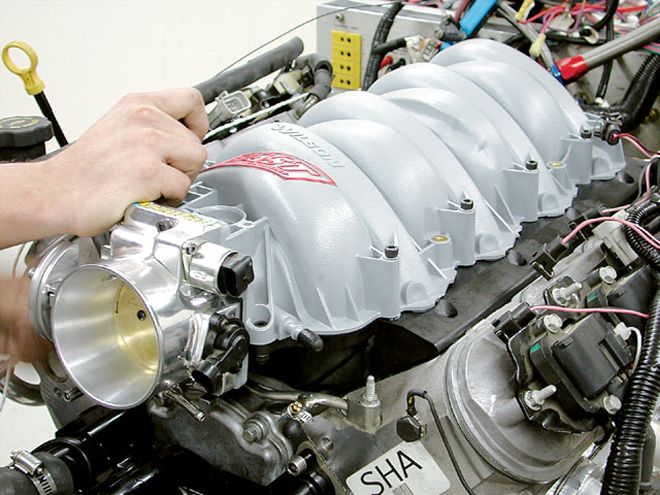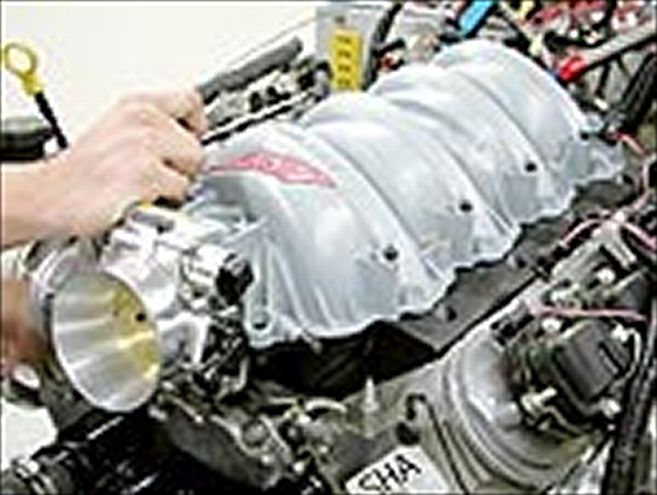


Nothing ever stays the same for long-technology makes sure of that. Not all that long ago, high-tech was a digital electronic ignition system. Today, the new LS1 and LS6 GM engines are pushing the envelope of performance and bringing the aftermarket right along with them. One of the hallmarks of the performance-oriented Gen III engines is their use of a composite intake manifold. This material, which most enthusiasts would refer to as plastic, not only reduces weight over a comparable aluminum casting, but also improves performance by not absorbing heat from the rest of the all-aluminum engine.
So it would stand to reason that if you were going to build a performance version of the LS1 or LS6 intake manifold, you would also make it out of a composite material. This is where production becomes precarious since this is relatively new ground. But the Fuel Air Spark Technology company (FAST) was not afraid to take on the challenge, and the result is the new LSX intake. Let's take a look at some of its features.
This intake is groundbreaking, not only because of its composite material makeup, but also because it is actually molded in three separate pieces. This allows the engine-builder easy access to the ports for minor whittling in order to fine-tune the intake to his particular combination. The composite polymer material that FAST uses is also 20 percent stronger and 25 percent stiffer than the stock LS1 intake, which not only improves its durability but also can be used for supercharged or nitrous applications. In addition, the intake is also available with optional burst panels in the base that will pop open and relieve intake pressure should a backfire occur in the intake tract.
While the intake is designed as a direct replacement for both the LS1 and LS6 intakes and looks very similar, FAST, with help from acknowledged induction artist Keith Wilson of Wilson Manifolds, exerted a tremendous amount of design effort to improve the intake's flow potential both in stock and performance applications. One of the more interesting aspects of the design of this intake was to employ a computational fluid dynamics (CFD) computer program to design the intake ports. To begin with, FAST increased the plenum area by an amazing 25 percent to ensure that the main area was not a restriction to inlet air to each individual intake port. FAST has also included witness marks to indicate how much material you can remove without getting into the intake's sealing areas. Part of this effort also increased the size of the inlet that mounts the throttle, for a 78mm throttle-body. A different top allows the use of a 90mm throttle-body.
The LSX intake is designed as a true bolt-on, and will fit under the hood of Corvettes, Camaros, and Firebirds. But while it make look similar to the stock intake, the LSX offers substantial improvements over either the stock LS1 or LS6 intake. The general consensus among most LS1 engine-builders is that the stock LS6 intake is worth roughly 5 to 10 hp over the stock LS1 intake. FAST's own tests indicate that the new LSX intake is worth 20 hp and 13 lb-ft of torque over a stock LS1 engine with the stock LS1 intake. When tested against the LS6 intake, the LSX also improved with an advantage of 15 hp and 7 lb-ft of torque. Perhaps most interesting of all is the plot we've also included that shows that the LSX intake improves the power output over an LS1 throughout the entire power curve from 2,800 all the way up through 6,000 rpm.
These are stock engine numbers, but when you begin adding a camshaft, better cylinder heads, and more compression, this is where the LSX can really shine. In one dyno test, an LS6 engine fitted with a Comp Cams hydraulic roller, ported heads, 90mm throttle-body, headers, and the LSX intake controlled by the FAST EFI system, this engine cranked out a stout 522 hp and a solid 461 lb-ft of torque.
But this manifold has far more potential than just for normally aspirated engines. The FAST folks have also equipped the LSX with integral nitrous bosses that will allow you to easily equip the LSX with individual nitrous injectors for each cylinder. If you'd rather employ a supercharger to stuff additional pressure into the intake, the FAST folks assured us that the LSX intake can handle positive manifold pressures of well in excess of 80 psi! Of course, those optional burst panels are also helpful just in case something unplanned occurs. The internal combustion engineers call those "excess pressure excursions"-we'll just call them hiccups.
Bolting the LSX intake on is a simple remove-and-replace operation, and you might also consider adding a larger, FAST 78mm throttle-body to go with the new intake. If you really want to get serious, you can also obtain an optional manifold that will accommodate up to a larger 90mm throttle-body for maximum performance. The manifold also comes equipped with its own integral rubber seals around all the intake ports as well as the throttle-body so you don't have to worry about installing gaskets. The only real variable has to do with earlier-model LS1 intakes that require a late-model coolant bypass and an oil sending unit. The LSX intake also uses a different PCV valve location compared to the older units, which duplicates the LS6 factory PCV valve modification.
The majority of these manifolds will probably end up on Gen III LS1- and LS6-powered Camaros, Corvettes, and Firebirds. But don't overlook the idea of one of these new intakes on an LS1 (or a 4.8, 5.3, or 6.0L truck engine) in an early musclecar or hot rod. While most of these engines will be controlled by the production computer, FAST also offers a very efficient standalone EFI controller that is fully capable of controlling any Gen III engine. These engines also employ a distributorless ignition system using individual ignition coils for each cylinder. The FAST system offers sequential fuel control as well as timing control for these engines and can also integrate multi-stage nitrous control and/or positive manifold pressures from supercharged/turbocharged applications. The manifold has been tested to withstand positive manifold pressures of up to 80 psi! The only limitation is your own imagination.
Regardless of whether you're new to late-model performance or just new to the performance scene in general, the basic concept around added performance revolves around improving the way air and fuel enter the cylinder. FAST has come up with a way to do that with a high-tech polymer intake that can increase power without adding weight all while looking more like the stock intake. Add up all the features, and it's easy to see that the power is there, just waiting to be used.
Parts List Component Part Number LSX intake, up to 78mm throttle-body 54001 LSX intake, up to 90mm throttle-body 54003